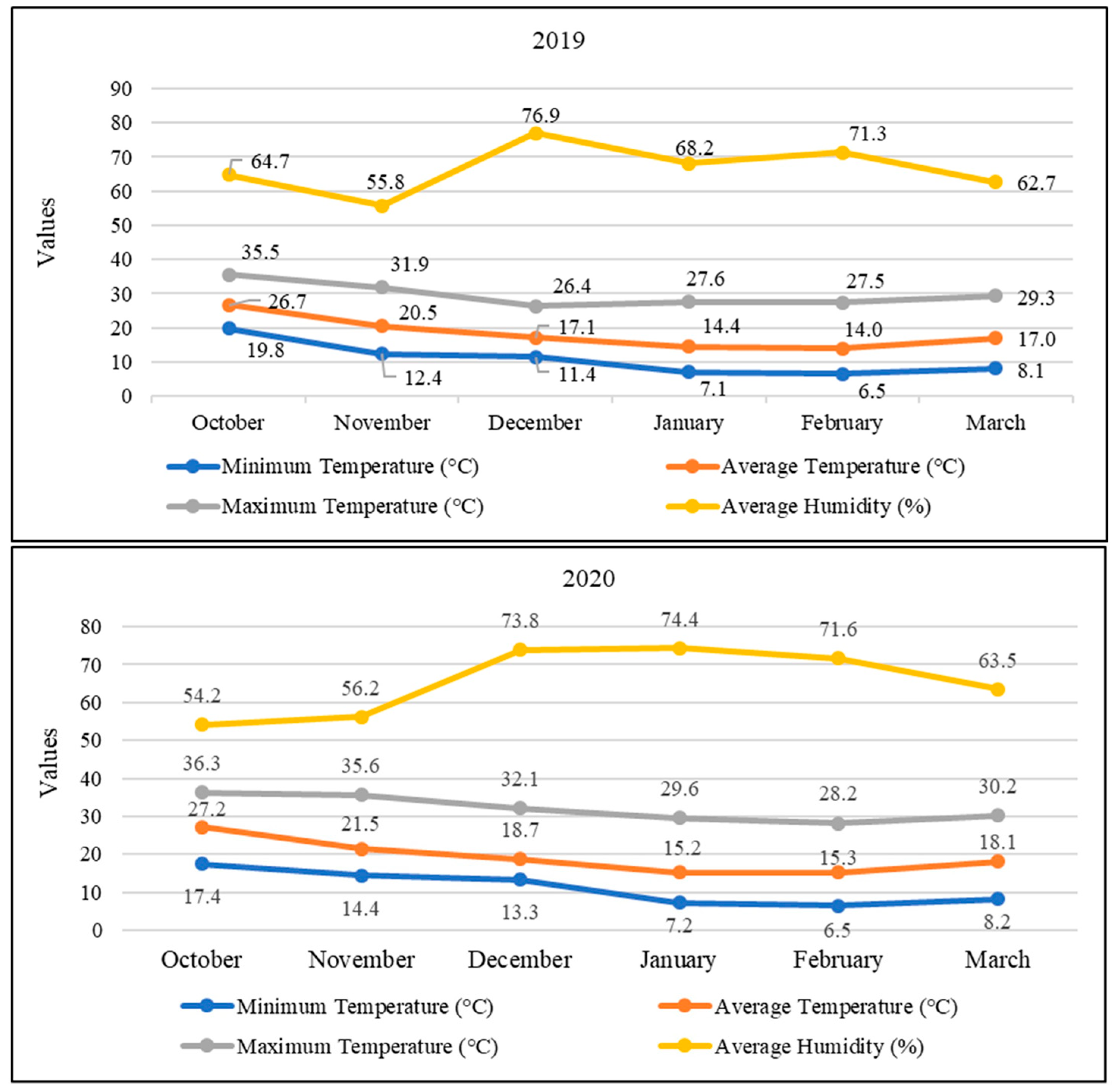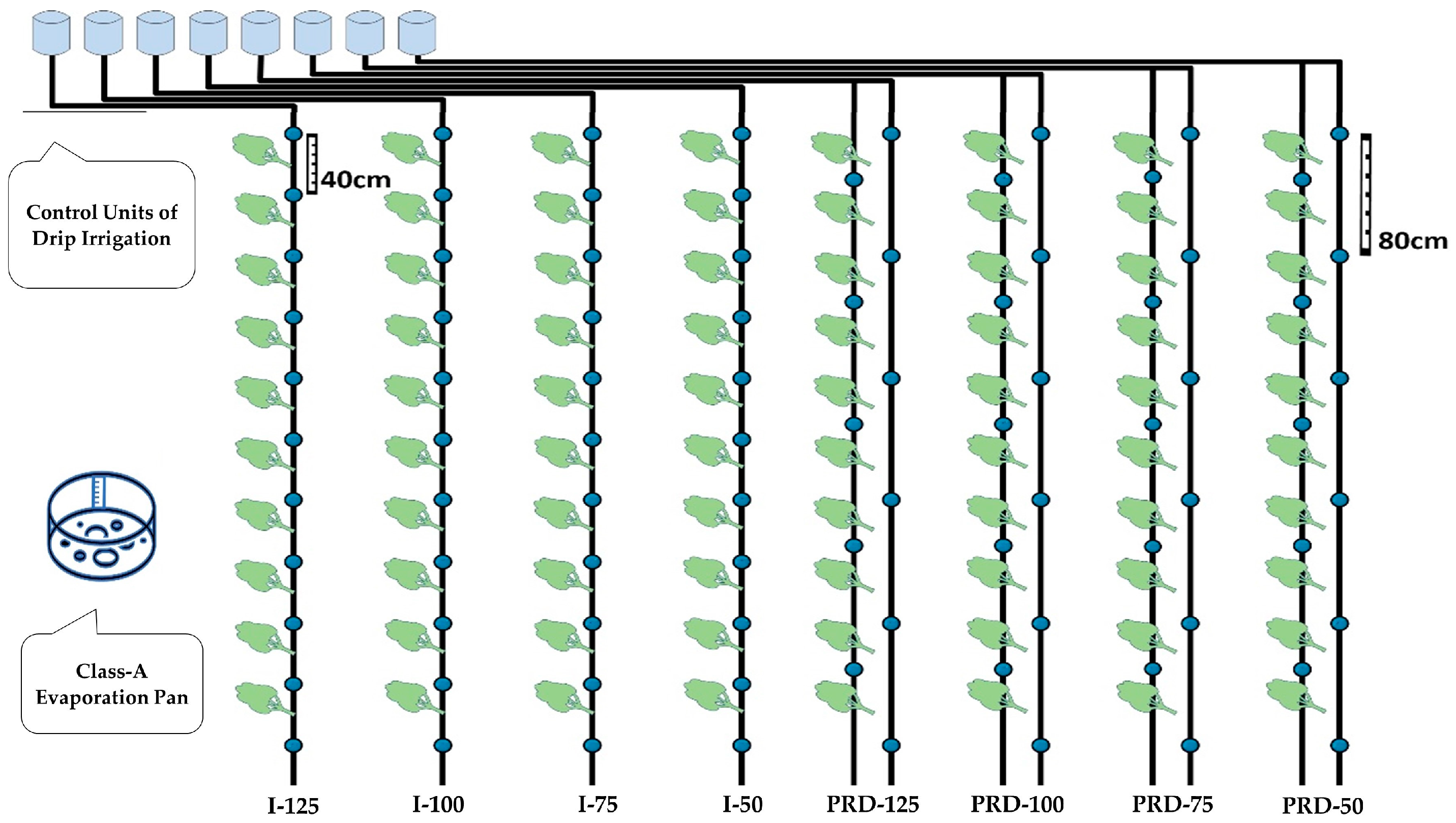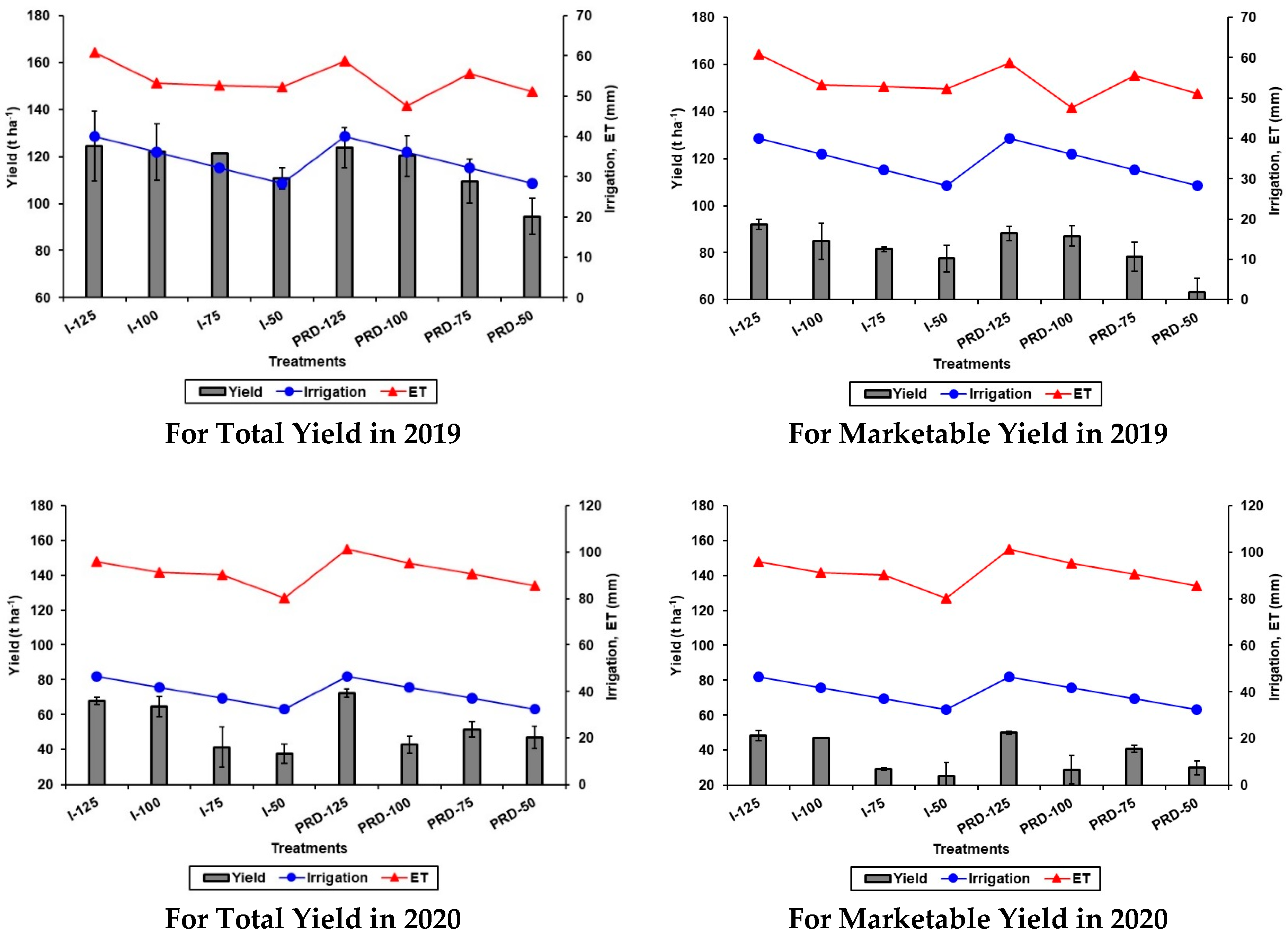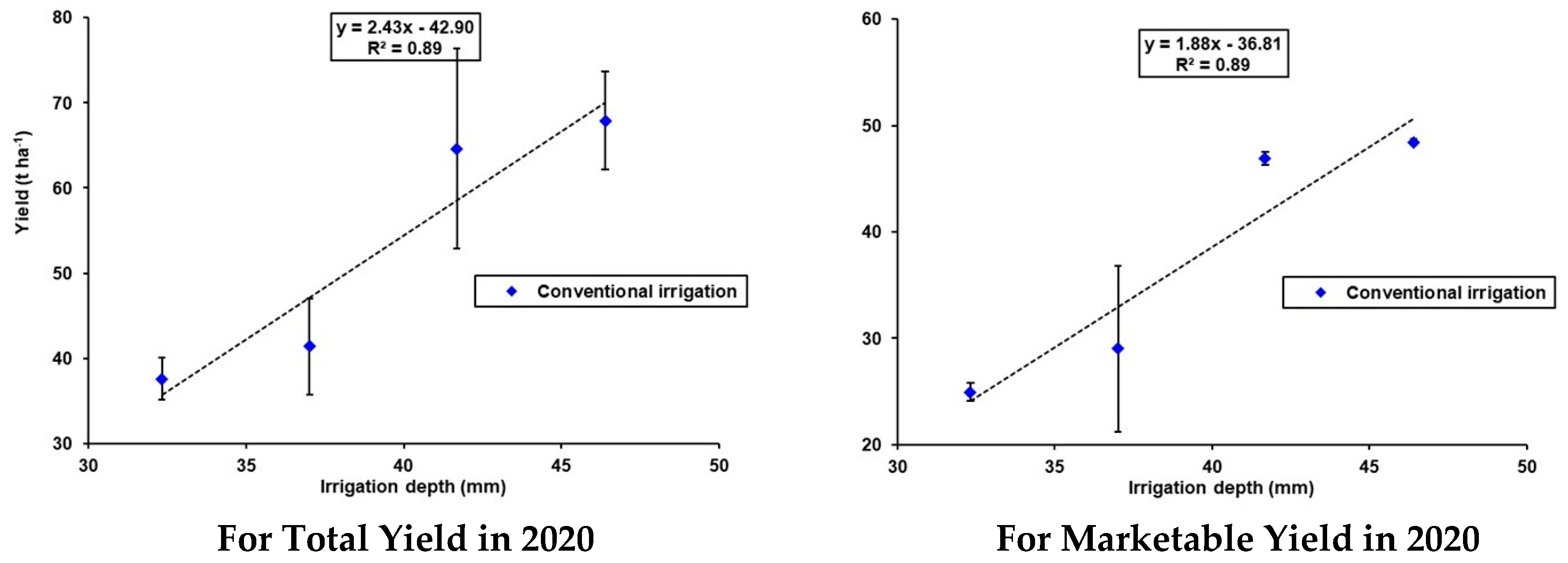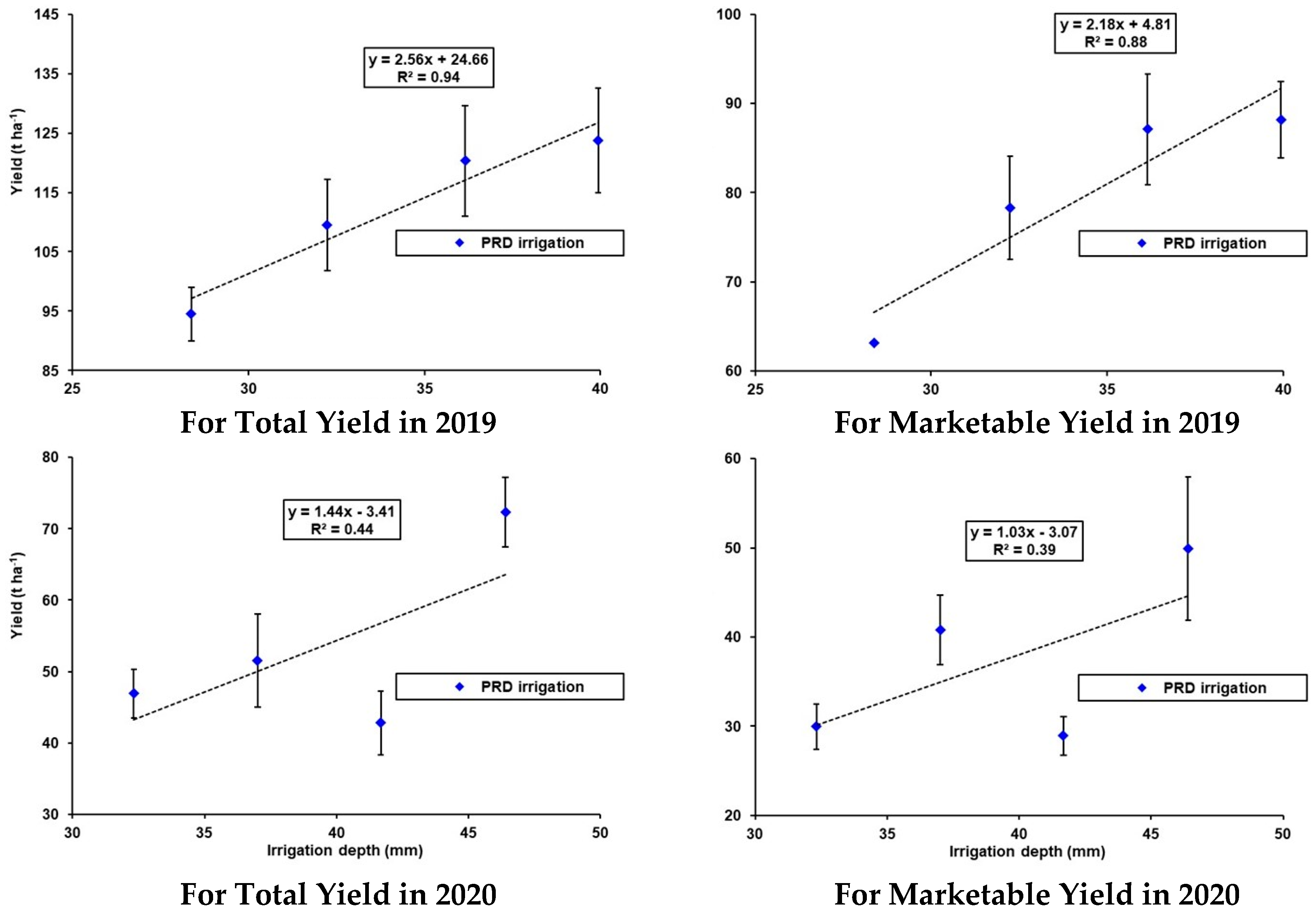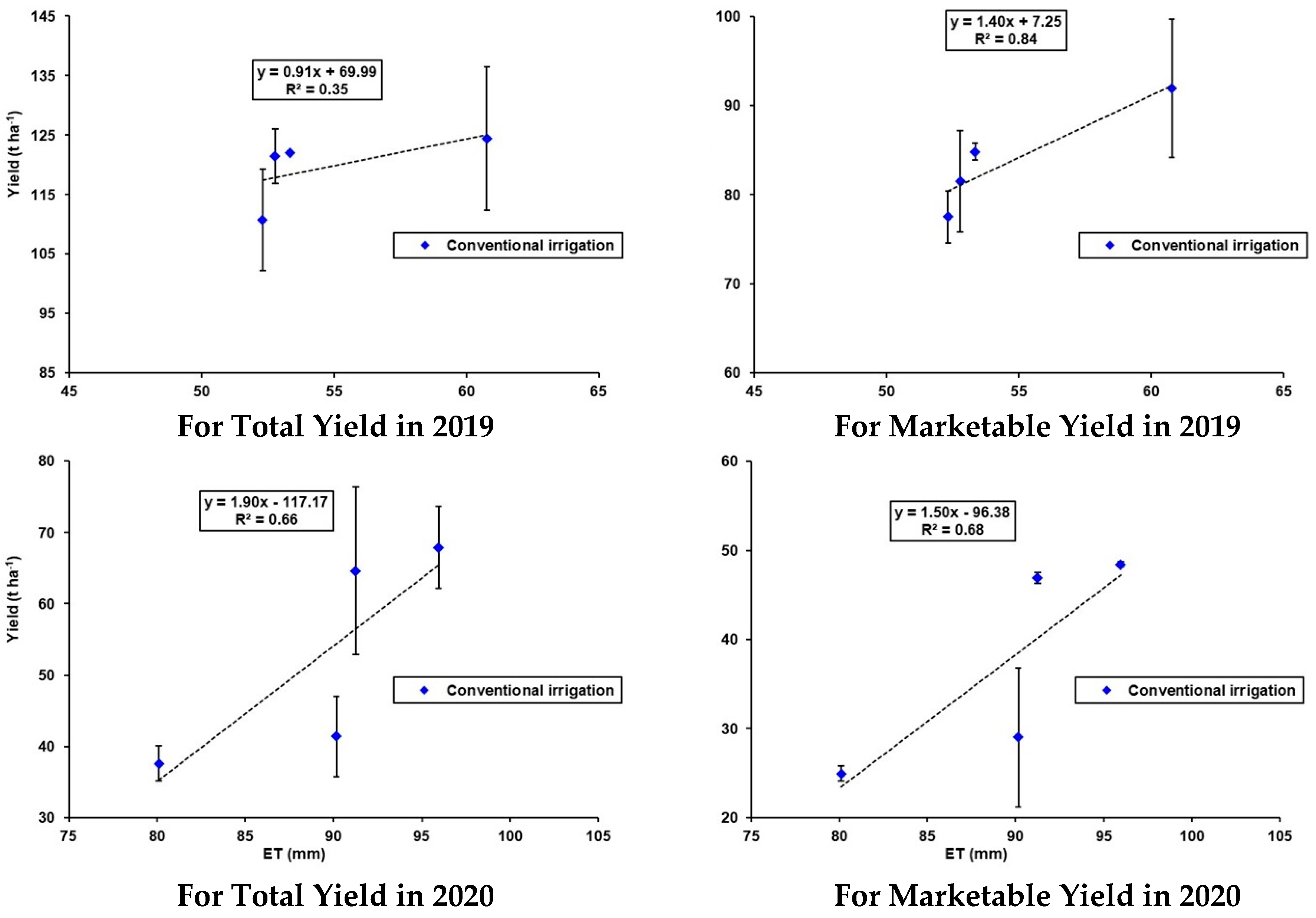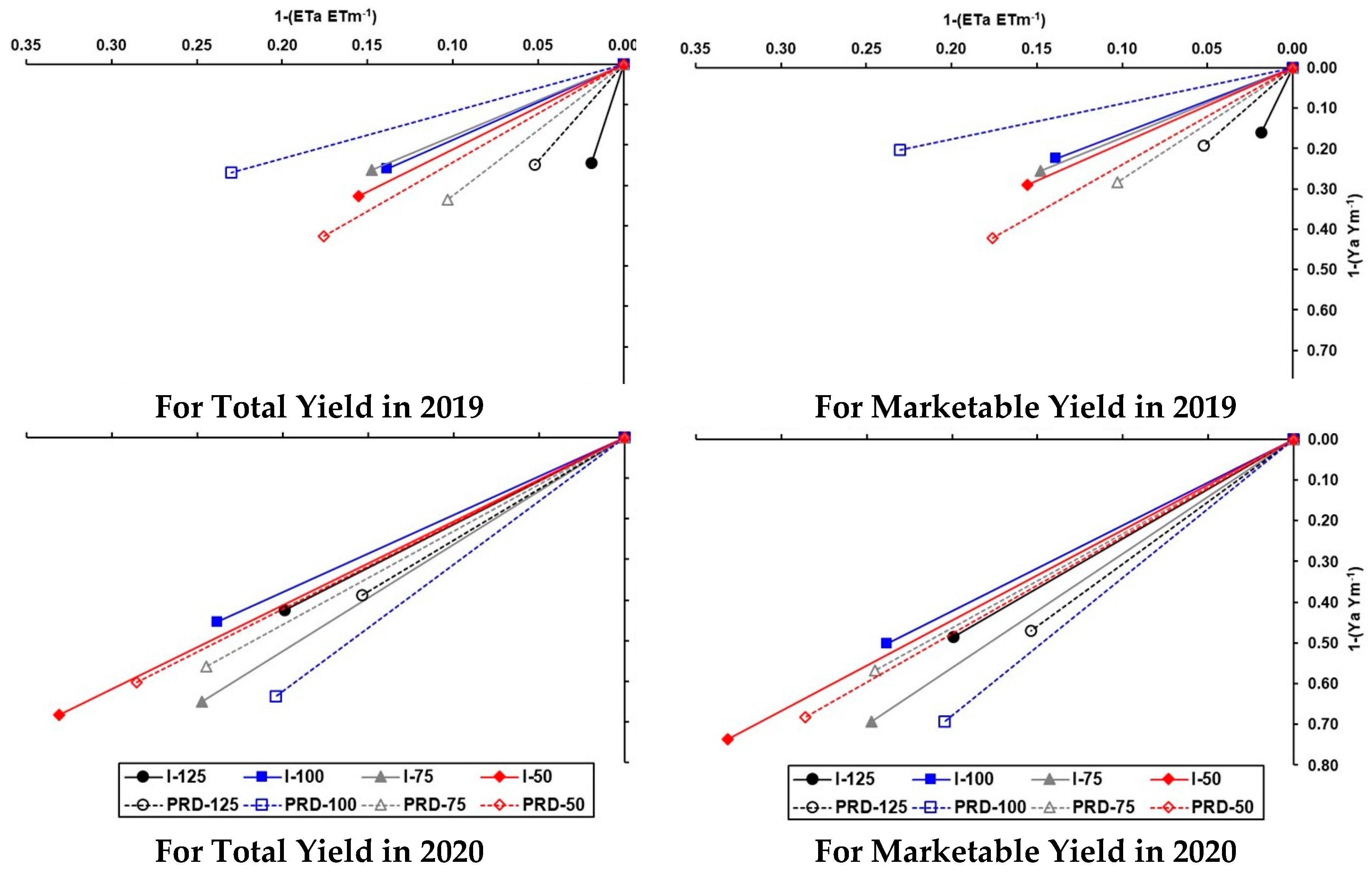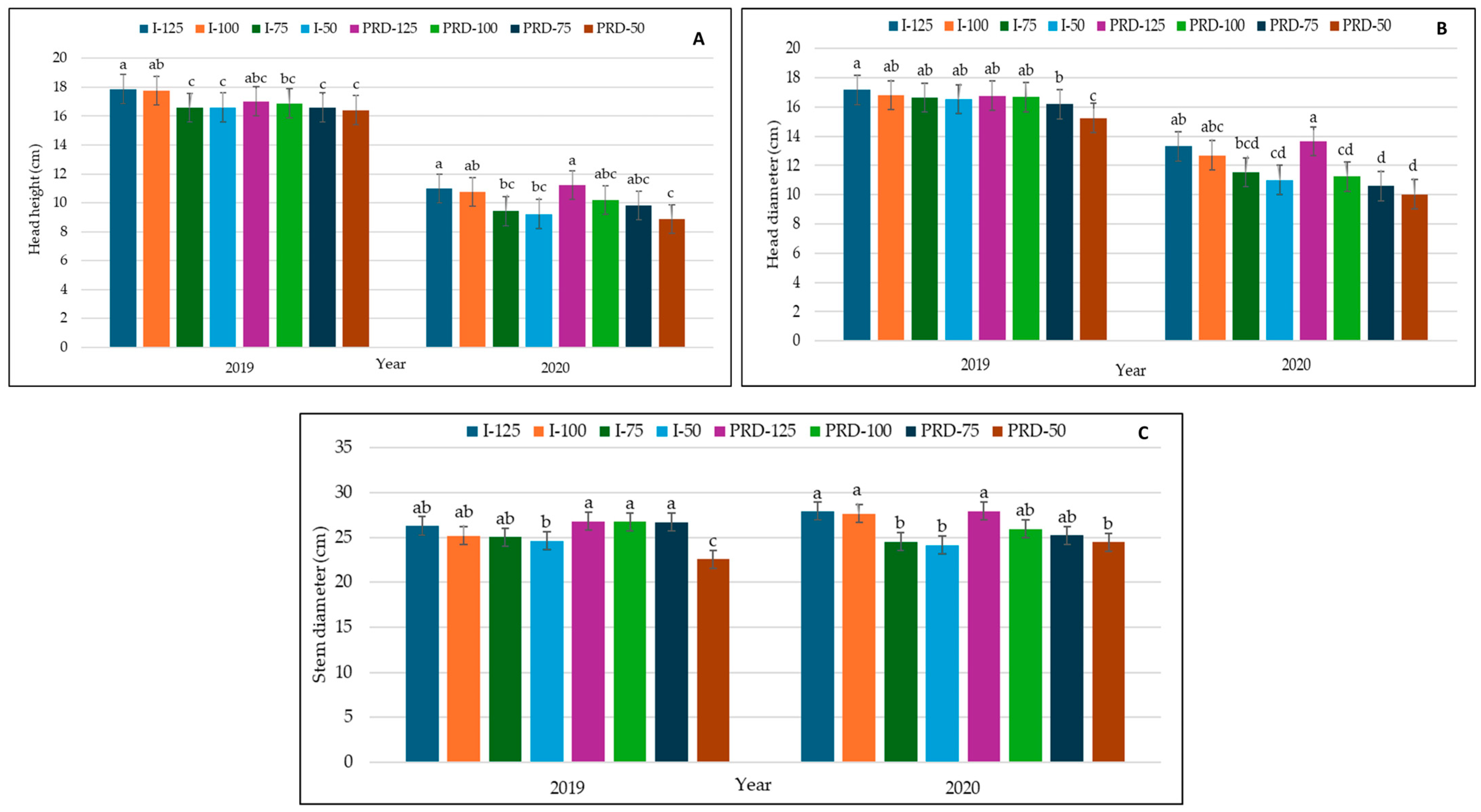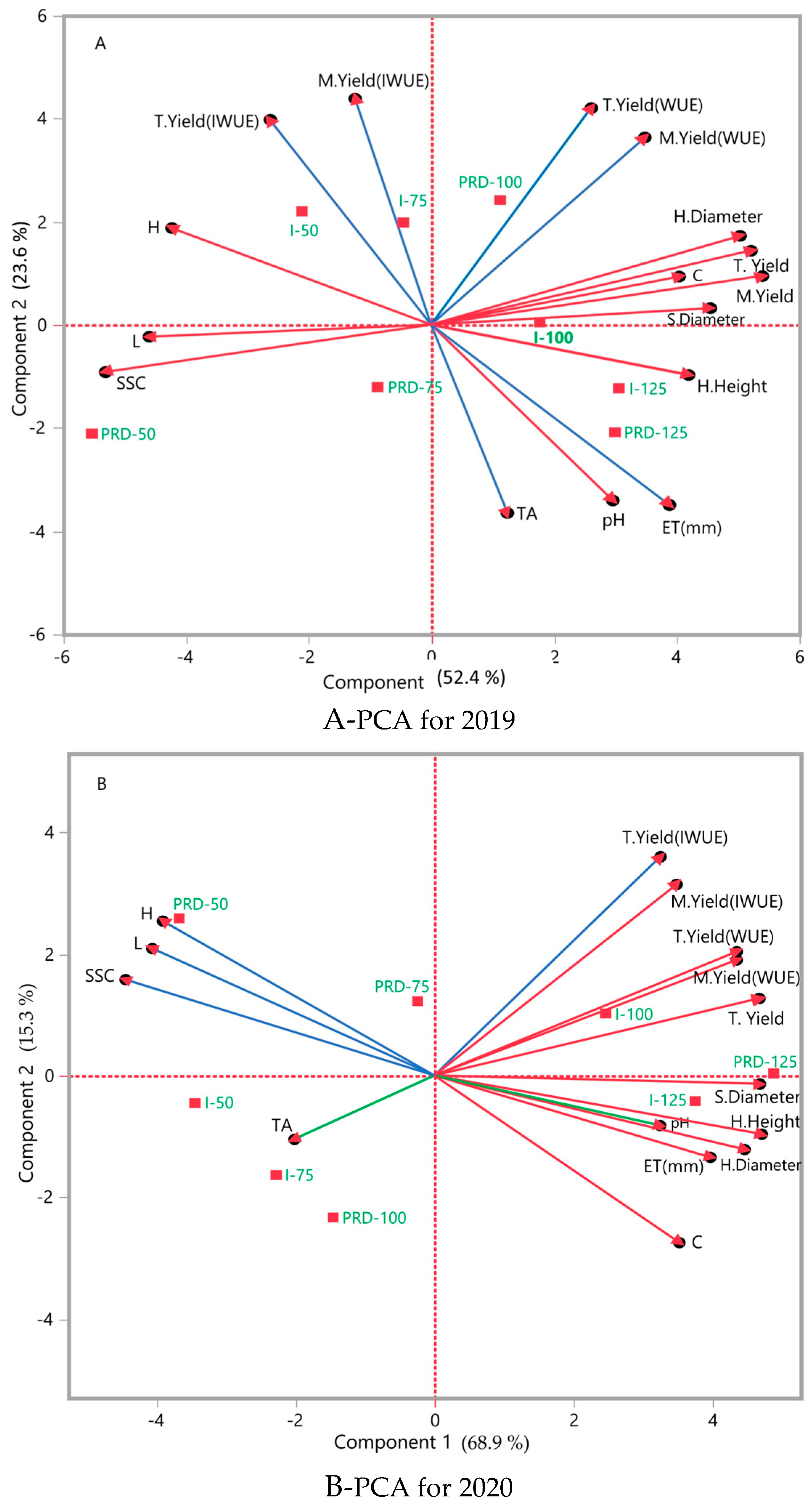3.1. Irrigation Water (I), Evapotranspiration (ET), Yield, Water Use Efficiency (WUE), Irrigation Water Use Efficiency (IWUE), and Yield Response Factor (ky)
The irrigation water (I, mm) and plant water consumption (ET, mm) values are given in
Table 3. In the first year, a total of 29 irrigations were made, including life water, and 27 irrigations were made in the second year. However, in the second year, the water requirements of the plants increased due to the climatic conditions (
Figure 1). This is because the average temperature in the second year was higher than in the first. As a result, the amount of irrigation water varied between 28.37 mm and 39.94 mm in the first season and between 32.32 mm and 46.40 mm in the second season (
Table 3). ET values were calculated between 47.69 mm and 60.78 mm in the first season and between 80.11 mm and 101.37 mm in the second season (
Table 3).
As mentioned in the methods section, ET was calculated according to Equation (2). ET is one of the important parameters in water-yield relationships. When the ET values for four different irrigation levels (125%, 100%, 75%, and 50%) and the PRD technique were considered, as expected, they showed significant changes for both seasons. As seen in
Table 3, for regions where water is scarce and expensive, it is important to consider 75% irrigation levels.
In general, a decrease in ET values was observed as the irrigation water level decreased. On the other hand, according to the data in
Table 3, the increase in ET values in response to the irrigation program and the amount of water applied is the most important indicator that there is no deep infiltration (surface runoff was not observed anyway) and that the irrigation management is correct. This situation proves that water is used most efficiently in cabbage cultivation.
It was found that the values of total and marketable yield (t ha
−1) were statistically affected by the irrigation program applied, and the details are given in
Table 4. In the first season, the highest total yield of 124.40 t ha
−1 was recorded in I-125 and the lowest yield of 94.53 t ha
−1 was recorded in PRD-50. However, the yield values of I-125, I-100, I-75, PRD-125, and PRD-100 plots were statistically similar. In the second season, the highest total yield was found as 72.33 t ha
−1 in PRD-125 and the lowest yield was found as 37.58 t ha
−1 in I-50. Statistically, I-125, I-100, and PRD-125 subjects showed statistical similarity in terms of total yield (
Table 4).
The marketable yield values were calculated as follows: In the first season, the highest value was 91.93 t ha
−1 in I-125 and the lowest value was 63.17 t ha
−1 in PRD-50 treatment (
Table 4). I-125, I-100, PRD-125, and PRD-100 subjects were in the same group with the highest marketable yield values. In the second season, the total highest value was 49.92 t ha
−1 in PRD-125 while the lowest yield was 24.94 t ha
−1 in I-50. However, I-125, I-100, and PRD-125 had statistically equal and the highest marketable yield values. In general, similar results were obtained for the irrigated treatments in terms of total and marketable yields. As the amount of irrigation water decreased (
Table 3), a decrease in yield values (
Table 4) was also observed.
Water use efficiency (WUE) and irrigation water use efficiency (IWUE) values were statistically influenced by irrigation programs and amount, and the results are shown in
Table 5. The WUE and IWUE, which are the most important parameters and can be used to show the effectiveness of water-saving methods, played a very important role. In the study, there were changes in yield, evaporation, and water amounts due to seasonal effects that affected the WUE and IWUE values. For total yield, the highest WUE value (252.31 kg m
−3) was calculated in PRD-100 and the lowest (185.19 kg m
−3) in PRD-50 in the first year (
Table 5). The highest WUE value (71.35 kg m
−3) was found in PRD-125 and the lowest (44.90 kg m
−3) in PRD-100 in the second year. For the marketable yield, the highest WUE value (182.65 kg m
−3) was calculated in PRD-100 and the lowest (123.76 kg m
−3) in PRD-50 in the first year (
Table 5). In the second year, the highest WUE value (51.44 kg m
−3) was found in I-100 and the lowest (30.36 kg m
−3) in PRD-100.
For total yield, the highest IWUE value (390.13 kg m
−3) was calculated for I-50 in the first year and the lowest (309.88 kg m
−3) was determined for PRD-125 (
Table 5). The highest WUE value (155.89 kg m
−3) was obtained for PRD-125 and the lowest (102.68 kg m
−3) for PRD-100 in the second year. For the marketable yield, the highest IWUE value (273.20 kg m
−3) was calculated for I-50 in the first year and the lowest (220.81 kg m
−3) for PRD-125 (
Table 5). The highest IWUE value (112.62 kg m
−3) was recorded for I-100 and the lowest (69.43 kg m
−3) for PRD-100 in the second year.
To more clearly demonstrate the water-yield relationships for cabbage in the study, visual representations of total and marketable yield, irrigation water, and evapotranspiration (ET) values are presented in
Figure 3. The finding that evapotranspiration (ET) values were higher than the amount of irrigation water applied throughout the study provides compelling evidence that the water was used in an optimal manner, with no losses such as deep infiltration into the soil. The irrigation management was appropriate and effective. On the other hand, it was found that the reduction in the amount of irrigation water also led to a reduction in yield (
Figure 3).
As illustrated in
Figure 4, the correlation between conventional irrigation (I-125, I-100, I-75, and I-50) and yield demonstrated a notable increase in yield values (
Table 4) with the application of increased irrigation water. This finding also lends support to the observed increase in water potential (IWUE) (
Table 5,
Figure 3).
As with
Figure 4, the correlation between the PRD technology (PRD-125, PRD-100, PRD-75, and PRD-50) and yield can be observed in
Figure 5. It can be generally stated that the observed increase in yield values (
Table 4) is attributable to the increase in irrigation water. Furthermore, this resulted in an increase in the IWUE values (
Table 5,
Figure 3). While not identical to
Figure 4 and
Figure 5, it is evident that the relationship between evapotranspiration (ET, mm) and yield (t ha
−1) is influenced by the quantity of irrigation water applied (
Figure 6 and
Figure 7).
“ky” values were calculated as an indicator of the effect of the proportional decrease in plant water use (ET) on the proportional decrease in cabbage yield. The relationship between seasonal plant water use and yield values was determined using regression analysis (
Figure 8). As in
Table 4,
Figure 3,
Figure 6 and
Figure 7, the decrease in yield values was generally found to be significant in response to the decrease in ET values (
Figure 8).
3.5. Pearson Correlation Analyses
The positive or negative proportional effect of different irrigation applications on the criteria studied in cabbage was evaluated using Pearson correlation analysis (
p < 0.05). In the correlation analysis, the mean values of the studied criteria according to the treatments were used. The correlation analysis and its coefficients are shown in
Figure 10.
Correlation coefficients showed a positive relationship between total yield and marketable yield, head diameter and C color parameters, stem diameter, and WUE for the first-year marketable yield. However, there was a negative relationship between total yield and SSC, L* and h∘ color parameters. While a positive relationship was determined between marketable yield and head and stem diameter, WUE for marketable yield and head height, a negative relationship was determined with SSC, L*, and h° color parameters. WUE for total yield had a strong positive relationship with WUE for marketable yield. IWUE for total yield had a strong positive relationship with IWUE for marketable yield. However, its relationship with pH was strong and negative. IWUE determined for marketable yield had a significant negative relationship only with pH of cabbage juices. Similarly, a negative relationship was determined for ET with H color parameter. Head height was related to stem diameter (positive) and colour parameter L (negative), stem diameter was related to colour parameters SSC (negative), L* (negative), and C (positive), stem diameter was related to SSC (negative) and L* (negative), SSC was related to L (positive), and colour parameter C (negative) was related to h°.
Upon evaluation of the significance of the correlation for the second year in terms of the parameters studied, it was observed that there were mutually strong positive relationships between marketable yield, WUE, and IWUE for total and marketable yield. ET appeared to have a positive relationship with total and marketable yield. It would appear that head height had a positive relationship with total and marketable yield, as well as with their WUE-IWUE and ET. As shown in
Figure 10, head diameter, stem diameter, and pH had some positive significant relationships. SSC had negative significant relationships with some other parameters. While the significant relationships of L* color parameter were negative, its relationship with SSC was a strong positive relationship. There were also positive and negative relationships for C* and h° color parameters.
3.6. Principle Component Analysis (PCA)
Principal component analyses were performed on the criteria examined in the study over a 2-year period (
Figure 11). The results of the investigation were analyzed in order to ascertain whether there were any notable differences in the averages of the various criteria according to the different irrigation regimes. The colors of the arrows on the graphs indicate the parameters with negative and positive loads included in the components. The graph shows two components for the first and second years. Although two components are shown in the second year, the parameter of the third component with the third higher load is also included in the graph. The red color indicates the first component, the blue colour indicates the second component and the green color indicates the third component. In the PCA carried out in the first year (
Figure 11A), it can be seen that the first principal component accounts for 52.4%, the second principal component 23.6%, and the total variation 76%. In the PCA carried out in the second year (
Figure 11B), the first component reached 68.9%, the second component reached 15.8%, and the total variation reached 84.7%.
In the first year of the research, the first component included marketable yield, total yield, head diameter, stem diameter, head height, C* colour, pH, and water use efficiency according to marketable yield criteria according to factor loadings, while the second component included irrigation water use efficiency according to marketable yield, irrigation water use efficiency according to total yield, and water use efficiency according to marketable yield. In the PCA analysis conducted for the second year of the research, the first component consisted of the following factors: head height, stem diameter, total yield, marketable yield, head diameter, water use efficiency by total yield, water use efficiency by marketable yield, total evaporation, chroma colour value, irrigation water use efficiency by marketable yield, irrigation water use efficiency by total yield, and pH criteria. In the second component, irrigation water use efficiency by total yield, irrigation water use efficiency by marketable yield, and h colour value came to the fore. In both the first and second years of the study, the SSC, L*, and h° parameters in the component were the ones with strong negative loadings.
